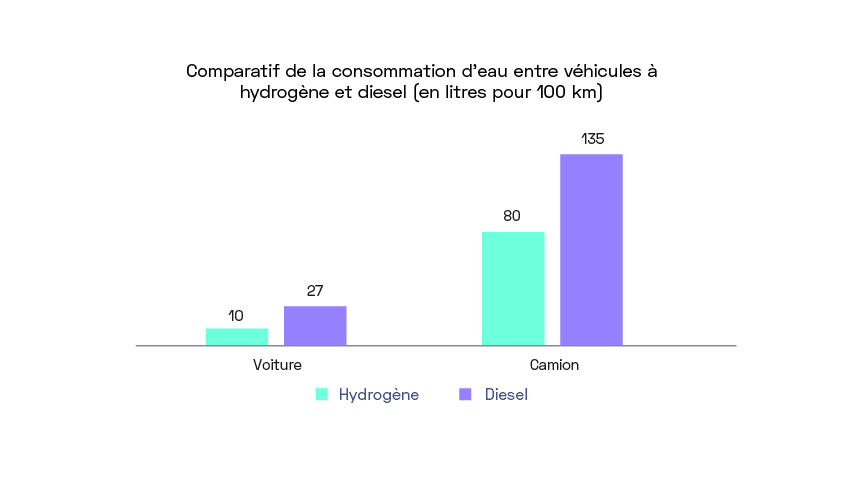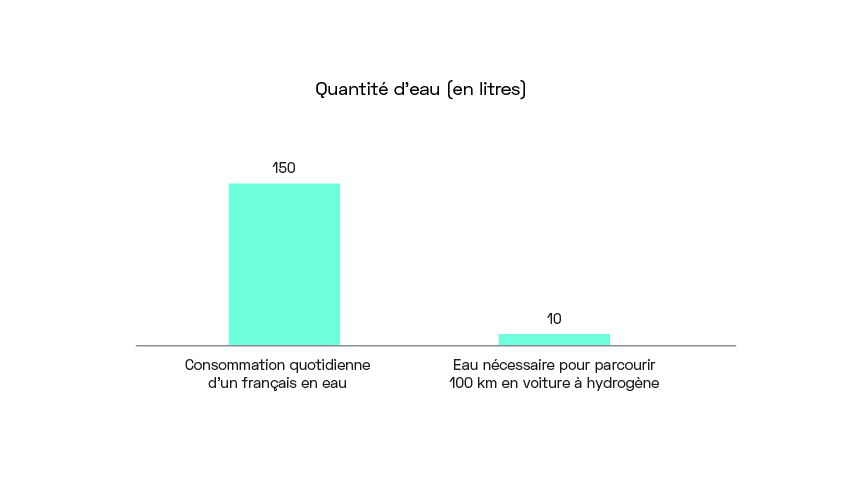Published the 26/07/2023
Responsible Water Management at the Heart of Our Production
At Lhyfe, we often talk about CO₂ and how green hydrogen production helps save tons of it. However, preserving natural resources is also a priority. As a producer of renewable hydrogen through water electrolysis, we have integrated the issue of access to this essential resource since the very foundation of our company. Unlike other industries, our water consumption remains low and is strictly controlled, ensuring minimal environmental impact. Here are some concrete figures to prove it!
How Much Water Is Needed to Produce Hydrogen?
Water electrolysis allows the production of hydrogen using renewable electricity and purified water. At Lhyfe, we use seawater, which we purify to a 99.9% purity level to ensure process efficiency. Measurements taken at our Bouin plant show that producing 1 kg of renewable hydrogen requires approximately 10.09 liters of purified seawater—about the capacity of a standard bucket.
As for our water discharges, they mainly consist of slightly saltier water, which is diluted again before being discharged into the marine environment, of course within the environmental authorities (DREAL). We are also exploring solutions to repurpose this brine, particularly in certain industrial applications.
Comparison with Diesel Water Consumption
When comparing our water consumption to that of diesel production, the differences are significant. Several studies indicate that producing 1 liter of diesel requires between 3 and 8 liters of water (1) (2), considering extraction, refining, and transportation. This may seem lower than hydrogen, but the key lies in energy density.
Since 1 kg of hydrogen has a greater energy density than 1 liter of diesel, in vehicle use, the actual water consumption is as follows:
- A diesel vehicle traveling 100 km consumes between 18 and 36 liters of water (for 6 liters of diesel). A hydrogen vehicle covering the same distance uses only 10 liters of water.
- For trucks, a diesel truck consumes about 30 liters of diesel per 100 km, requiring around 135 liters of water. Meanwhile, a hydrogen truck would only need 80 liters of water.

Thus, on a fleet-wide scale, in addition to reducing greenhouse gas emissions, producing and using renewable hydrogen significantly reduces the water consumption required for energy production!
Finally, this water is not lost, as it is expelled through the exhaust of a hydrogen vehicle. Hydrogen fuel cells generate electricity by combining hydrogen with oxygen, producing not only electrical power but also water! Therefore, the entire process can be considered a closed water cycle—water is “used” but ultimately very little is actually consumed.
Reverse Osmosis and Impact on Water Extraction
Lhyfe uses reverse osmosis, a water filtration process that relies on an ultrafine membrane to retain impurities, salts, and pollutants. This process is optimized to minimize the volume of water extracted and discharged.
At our Bouin plant, for example, we produce 300 kg of hydrogen per day, drawing 20 m³ of seawater, of which only 3 m³ are actually used in production. The remaining 17 m³ are discharged as brackish water, in a controlled manner and in full compliance with regulatory requirements.
A Negligible Water Consumption Compared to Other Uses
To put our water consumption into perspective:
- The average French citizen consumes 150 liters of drinking water per day. (3)
- A 30 km trip in a hydrogen car requires only 3 liters of water, a negligible amount compared to an individual’s daily water usage.
Innovation and Optimization for Even More Efficient Water Use
Lhyfe continuously invests in innovative solutions to reduce its water footprint. Among the explored strategies:
- Reusing water vapor generated during hydrogen production by reinjecting it into the electrolysis process.
- Integrating water recovery systems to minimize reliance on external resources.
- Responsible brine management, with innovative solutions to preserve marine ecosystems.
A Strong Commitment to Resource Preservation
At Lhyfe, our commitment goes beyond renewable hydrogen production. We strive to optimize our water consumption, protect ecosystems, and collaborate with regulatory authorities to ensure sustainable production. Through rigorous management and continuous improvement, we position ourselves as a key player in the energy transition while preserving one of the most precious resources on our planet.
Lhyfe’s thinking goes even further: since we produce not only hydrogen but also oxygen, our teams are already thinking about the possibility of reinjecting the oxygen produced directly into the oceans, thereby promoting their reoxygenation and combating the acidification caused by global warming. To find out more, click here!
Making the world a more breathable place for future generations is the mission that Lhyfe has set itself since its creation.
- Study by Lawrence Berkeley National Laboratory: “Water and Energy Interactions” – 15/05/2013
- Study by Argonne National Laboratory: “Water Consumption in the Production of Ethanol and Petroleum Gasoline, Environmental Management 44” – 22/09/2009 – pages 981 to 997
- Database notre-environnement.gouv.fr: Domestic Drinking Water Consumption – Updated on January 11, 2023
Do you have a question or need more information?
Contact our team
Contact
Have a question or query? Need information? Talk to our team
